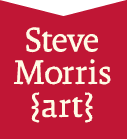This is the final painting for a life-size self-portrait I started in late 2013. These photographs of the painting are ones I took, but I'll eventually have it professionally photographed. There are a couple of places I'll touch up, but I think it's 99.9% finished...seeing work in a photo always highlights problems, but photos (at least the ones I took) seem to make the painting look a harsher than it does to the naked eye.
I don't normally paint on paper mounted panels, but it was an experiment. In the future, I'm going back to my standard use of panels without the paper. Acrylics sometimes form unwanted textures, and in this painting I overworked the glazing medium early on, which created pock marked areas. I was concerned about abrading the surface of the paper so I didn't sand the pocked areas until much later on, but it was essential too late to get rid of the texture by that point.
I think I may have spent as much time on the background as I did on the face. I usually paint whatever exist behind the subject, but in this case, the walls of the bathroom were creating some bad compositional lines, so I needed to shift where the walls sat. I added the towel (after several experiments) to fill the large open area and balance the negative space around my head. A fun fact: the towel is a ancient Dungeons & Dragons beach towel from the early 1980's.
The manner in which I painted this was a departure from my normal dry-brushing. Also, I didn't blend as much, leaving some paint stoke visibility, to get away from an overly smoothed effect. Golden's glazing medium is definitely the way to go to allow wet-on-wet blending (it as retarder in it), which is normally difficult with acrylics unless you use fluid acrylics or a lot of water. The glazing medium also facilitated visual blending, by using translucent layers of paint over dry areas and made it much easier to intensify areas of color, without having to repaint.
